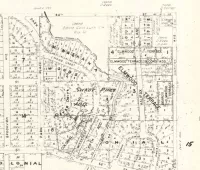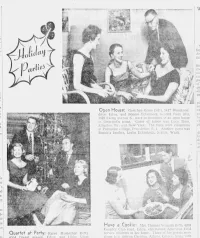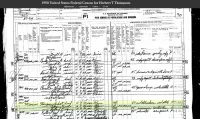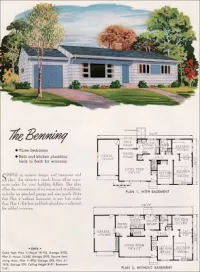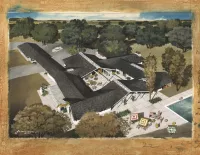Share what you know,
and discover more.
Share what you know,
and discover more.
Jun 08, 2015
Jun 08, 2015
5417 Woodcrest Drive, Minneapolis, MN, USA
Posted Date
Jun 17, 2024
Historical Record Date
Jun 08, 2015
Source Name
Redfin
Delete Story
Are you sure you want to delete this story?
Feb 12, 1967
Feb 12, 1967
Delete Story
Are you sure you want to delete this story?
Feb 24, 1963
Feb 24, 1963
Delete Story
Are you sure you want to delete this story?
Jan 01, 1960
Jan 01, 1960
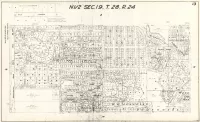
-

- Marley Zielike
Minnehaha Woods Neighborhood
The Minnehaha Woods neighborhood in Edina, MN, has a rich history that reflects the broader development of Edina as a city. Edina itself was established in the late 19th century, originally a small agricultural community that grew around the Edina Mill, which was built in the 1850s. Over time, Edina evolved into a suburban residential area, especially post-World War II, when suburban development boomed across the United States. Minnehaha Woods, located in the Northeastern part of Edina, is known for its beautiful natural surroundings, including mature trees and proximity to Minnehaha Creek. This area likely saw significant development in the mid-20th century, aligning with the suburban expansion in the region. Key points in the history of the Minnehaha Woods neighborhood include: Early Settlement: The area around Minnehaha Creek was initially inhabited by Native American tribes, primarily the Dakota. European settlers arrived in the mid-19th century, establishing farms and mills. Suburban Development: Post-World War II, the neighborhood saw increased residential development as part of the suburbanization of Edina. This period marked the transformation of the area from rural to suburban. Community Growth: As Edina grew, Minnehaha Woods became a desirable residential area due to its natural beauty and convenient location. The neighborhood is characterized by single-family homes, many of which were built in the mid-20th century. Modern Era: Today, Minnehaha Woods is a well-established neighborhood known for its scenic environment, community-oriented atmosphere, and high quality of life. It continues to be a sought-after location within Edina. The neighborhood's development mirrors the broader trends in Edina's growth, from an agricultural community to a suburban city, and its ongoing appeal as a residential area.
Minnehaha Woods Neighborhood
The Minnehaha Woods neighborhood in Edina, MN, has a rich history that reflects the broader development of Edina as a city. Edina itself was established in the late 19th century, originally a small agricultural community that grew around the Edina Mill, which was built in the 1850s. Over time, Edina evolved into a suburban residential area, especially post-World War II, when suburban development boomed across the United States. Minnehaha Woods, located in the Northeastern part of Edina, is known for its beautiful natural surroundings, including mature trees and proximity to Minnehaha Creek. This area likely saw significant development in the mid-20th century, aligning with the suburban expansion in the region. Key points in the history of the Minnehaha Woods neighborhood include: Early Settlement: The area around Minnehaha Creek was initially inhabited by Native American tribes, primarily the Dakota. European settlers arrived in the mid-19th century, establishing farms and mills. Suburban Development: Post-World War II, the neighborhood saw increased residential development as part of the suburbanization of Edina. This period marked the transformation of the area from rural to suburban. Community Growth: As Edina grew, Minnehaha Woods became a desirable residential area due to its natural beauty and convenient location. The neighborhood is characterized by single-family homes, many of which were built in the mid-20th century. Modern Era: Today, Minnehaha Woods is a well-established neighborhood known for its scenic environment, community-oriented atmosphere, and high quality of life. It continues to be a sought-after location within Edina. The neighborhood's development mirrors the broader trends in Edina's growth, from an agricultural community to a suburban city, and its ongoing appeal as a residential area.
Minnehaha Woods Neighborhood
The Minnehaha Woods neighborhood in Edina, MN, has a rich history that reflects the broader development of Edina as a city. Edina itself was established in the late 19th century, originally a small agricultural community that grew around the Edina Mill, which was built in the 1850s. Over time, Edina evolved into a suburban residential area, especially post-World War II, when suburban development boomed across the United States.Minnehaha Woods, located in the Northeastern part of Edina, is known for its beautiful natural surroundings, including mature trees and proximity to Minnehaha Creek. This area likely saw significant development in the mid-20th century, aligning with the suburban expansion in the region.
Key points in the history of the Minnehaha Woods neighborhood include:
Early Settlement: The area around Minnehaha Creek was initially inhabited by Native American tribes, primarily the Dakota. European settlers arrived in the mid-19th century, establishing farms and mills.
Suburban Development: Post-World War II, the neighborhood saw increased residential development as part of the suburbanization of Edina. This period marked the transformation of the area from rural to suburban.
Community Growth: As Edina grew, Minnehaha Woods became a desirable residential area due to its natural beauty and convenient location. The neighborhood is characterized by single-family homes, many of which were built in the mid-20th century.
Modern Era: Today, Minnehaha Woods is a well-established neighborhood known for its scenic environment, community-oriented atmosphere, and high quality of life. It continues to be a sought-after location within Edina.
The neighborhood's development mirrors the broader trends in Edina's growth, from an agricultural community to a suburban city, and its ongoing appeal as a residential area.
Posted Date
Jul 08, 2024
Historical Record Date
Jan 01, 1960
Source Name
Hennepin County Library and the Hennepin History Museum
Delete Story
Are you sure you want to delete this story?
Jul 19, 1957
Jul 19, 1957
Delete Story
Are you sure you want to delete this story?
Dec 28, 1956
Dec 28, 1956
Holiday Parties
Gretchen Gross of 5417 Woodcrest Drive is mentioned in the newspaper.Posted Date
Jun 17, 2024
Historical Record Date
Dec 28, 1956
Source Name
Star Tribune
Source Website
Delete Story
Are you sure you want to delete this story?
Nov 02, 1956
Nov 02, 1956
Delete Story
Are you sure you want to delete this story?
Apr 13, 1952
Apr 13, 1952
Delete Story
Are you sure you want to delete this story?
Apr 10, 1951
Apr 10, 1951
Delete Story
Are you sure you want to delete this story?
Apr 01, 1950
Apr 01, 1950
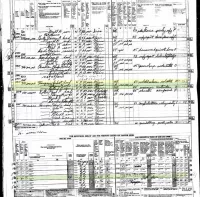
-

- Marley Zielike
1950 US Census
In 1950, Herbert Thompson (49), along with his wife Florence (46) and son Rolland (20) lived at 5417 Woodcrest Drive. Herbert worked as a Real Estate Agent and developer and made 53,000 in 1949. He didn't serve in World War 1 or 2, and his highest education was 2 years of college.
1950 US Census
In 1950, Herbert Thompson (49), along with his wife Florence (46) and son Rolland (20) lived at 5417 Woodcrest Drive. Herbert worked as a Real Estate Agent and developer and made 53,000 in 1949. He didn't serve in World War 1 or 2, and his highest education was 2 years of college.
1950 US Census
In 1950, Herbert Thompson (49), along with his wife Florence (46) and son Rolland (20) lived at 5417 Woodcrest Drive. Herbert worked as a Real Estate Agent and developer and made 53,000 in 1949. He didn't serve in World War 1 or 2, and his highest education was 2 years of college.Posted Date
Jul 09, 2024
Historical Record Date
Apr 01, 1950
Source Name
U.S. Census
Delete Story
Are you sure you want to delete this story?
Oct 05, 1949
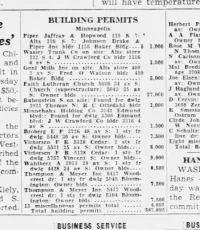
5417 Woodcrest Building Permit Notice
Building Permits in October of 1949. Thompson & Meyer Inc. of 5417 Woodcrest Drive file permit.
Oct 05, 1949
Delete Story
Are you sure you want to delete this story?
Oct 01, 1949
Oct 01, 1949
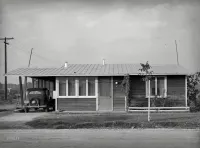
-

- Marley Zielike
Architecture and Design: Ranch Style Homes
The Ranch style of home architecture in America originated in the early 20th century and gained widespread popularity in the post-World War II era. This architectural style was influenced by Spanish Colonial and Craftsman design elements, emphasizing practicality and simplicity, making it a popular choice for development throughout the U.S. Originally, Ranch style homes were among the “small" houses built during the 1930s and 40s. They truly came into their own in the years following the Second World War. The earliest versions, known as the “Ranchette” or Transitional Ranch, are often found in neighborhoods alongside Minimal Traditional homes. Ranch homes frequently featured a covered “breezeway,” a small space between the garage and the house that provided a place to sit and enjoy the outdoors. These outdoor areas were very popular and included whenever space permitted. The Ranch home as we know it today originated in southern California during the mid-1930s, loosely based on the Spanish Colonial details of the American Southwest. Many sources cite the influence of Frank Lloyd Wright's Prairie style and his Usonian house concept, which emphasized a simple, natural dwelling, on the development of the Ranch house style. These concepts are evident in later Contemporary house styles. Several cultural factors contributed to the popularity of the Ranch style. Families moved away from a front porch lifestyle to a more informal, private patio style at the rear of the home. As the use of automobiles increased, more land became available for larger housing lots, encouraging suburban expansion. During the postwar housing boom of the 1940s and 1950s, Ranch-style homes became increasingly popular across America, thanks in part to their affordability, ease of construction, and adaptability to suburban development. The Ranch style symbolized the American Dream of homeownership and suburban prosperity, as millions of families moved into homes in newly built suburban neighborhoods. Photo 1: Early suburban ranch-style home on a Tulare County farm, 1940. Photo 2: The Benning Floorplan from the 1940s. Photo 3: Philbin house, Woodside, CA, 1959.
Architecture and Design: Ranch Style Homes
The Ranch style of home architecture in America originated in the early 20th century and gained widespread popularity in the post-World War II era. This architectural style was influenced by Spanish Colonial and Craftsman design elements, emphasizing practicality and simplicity, making it a popular choice for development throughout the U.S. Originally, Ranch style homes were among the “small" houses built during the 1930s and 40s. They truly came into their own in the years following the Second World War. The earliest versions, known as the “Ranchette” or Transitional Ranch, are often found in neighborhoods alongside Minimal Traditional homes. Ranch homes frequently featured a covered “breezeway,” a small space between the garage and the house that provided a place to sit and enjoy the outdoors. These outdoor areas were very popular and included whenever space permitted. The Ranch home as we know it today originated in southern California during the mid-1930s, loosely based on the Spanish Colonial details of the American Southwest. Many sources cite the influence of Frank Lloyd Wright's Prairie style and his Usonian house concept, which emphasized a simple, natural dwelling, on the development of the Ranch house style. These concepts are evident in later Contemporary house styles. Several cultural factors contributed to the popularity of the Ranch style. Families moved away from a front porch lifestyle to a more informal, private patio style at the rear of the home. As the use of automobiles increased, more land became available for larger housing lots, encouraging suburban expansion. During the postwar housing boom of the 1940s and 1950s, Ranch-style homes became increasingly popular across America, thanks in part to their affordability, ease of construction, and adaptability to suburban development. The Ranch style symbolized the American Dream of homeownership and suburban prosperity, as millions of families moved into homes in newly built suburban neighborhoods. Photo 1: Early suburban ranch-style home on a Tulare County farm, 1940. Photo 2: The Benning Floorplan from the 1940s. Photo 3: Philbin house, Woodside, CA, 1959.
Architecture and Design: Ranch Style Homes
The Ranch style of home architecture in America originated in the early 20th century and gained widespread popularity in the post-World War II era. This architectural style was influenced by Spanish Colonial and Craftsman design elements, emphasizing practicality and simplicity, making it a popular choice for development throughout the U.S.Originally, Ranch style homes were among the “small" houses built during the 1930s and 40s. They truly came into their own in the years following the Second World War. The earliest versions, known as the “Ranchette” or Transitional Ranch, are often found in neighborhoods alongside Minimal Traditional homes.
Ranch homes frequently featured a covered “breezeway,” a small space between the garage and the house that provided a place to sit and enjoy the outdoors. These outdoor areas were very popular and included whenever space permitted.
The Ranch home as we know it today originated in southern California during the mid-1930s, loosely based on the Spanish Colonial details of the American Southwest. Many sources cite the influence of Frank Lloyd Wright's Prairie style and his Usonian house concept, which emphasized a simple, natural dwelling, on the development of the Ranch house style. These concepts are evident in later Contemporary house styles.
Several cultural factors contributed to the popularity of the Ranch style. Families moved away from a front porch lifestyle to a more informal, private patio style at the rear of the home. As the use of automobiles increased, more land became available for larger housing lots, encouraging suburban expansion.
During the postwar housing boom of the 1940s and 1950s, Ranch-style homes became increasingly popular across America, thanks in part to their affordability, ease of construction, and adaptability to suburban development. The Ranch style symbolized the American Dream of homeownership and suburban prosperity, as millions of families moved into homes in newly built suburban neighborhoods.
Photo 1: Early suburban ranch-style home on a Tulare County farm, 1940.
Photo 2: The Benning Floorplan from the 1940s.
Photo 3: Philbin house, Woodside, CA, 1959.
Posted Date
Jul 09, 2024
Historical Record Date
Oct 01, 1949
Source Name
HouseNovel
Delete Story
Are you sure you want to delete this story?
Jun 01, 1930
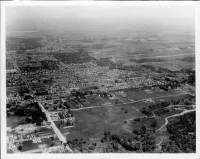
-

- Marley Zielike
Area Around Riley School Near 50th and France
View looking southeast over the Fulton Neighborhood. James Whitcomb Riley School is just left of center. The 50th and France business district is on the left side (50th Street running vertically and France Ave. running horizontally). Minnehaha Creek is in the lower right corner.
Area Around Riley School Near 50th and France
View looking southeast over the Fulton Neighborhood. James Whitcomb Riley School is just left of center. The 50th and France business district is on the left side (50th Street running vertically and France Ave. running horizontally). Minnehaha Creek is in the lower right corner.
Jun 01, 1930
Area Around Riley School Near 50th and France
View looking southeast over the Fulton Neighborhood. James Whitcomb Riley School is just left of center. The 50th and France business district is on the left side (50th Street running vertically and France Ave. running horizontally). Minnehaha Creek is in the lower right corner.Posted Date
Jul 09, 2024
Historical Record Date
Jun 01, 1930
Source Name
Hennepin County Library and the Hennepin History Museum
Delete Story
Are you sure you want to delete this story?





